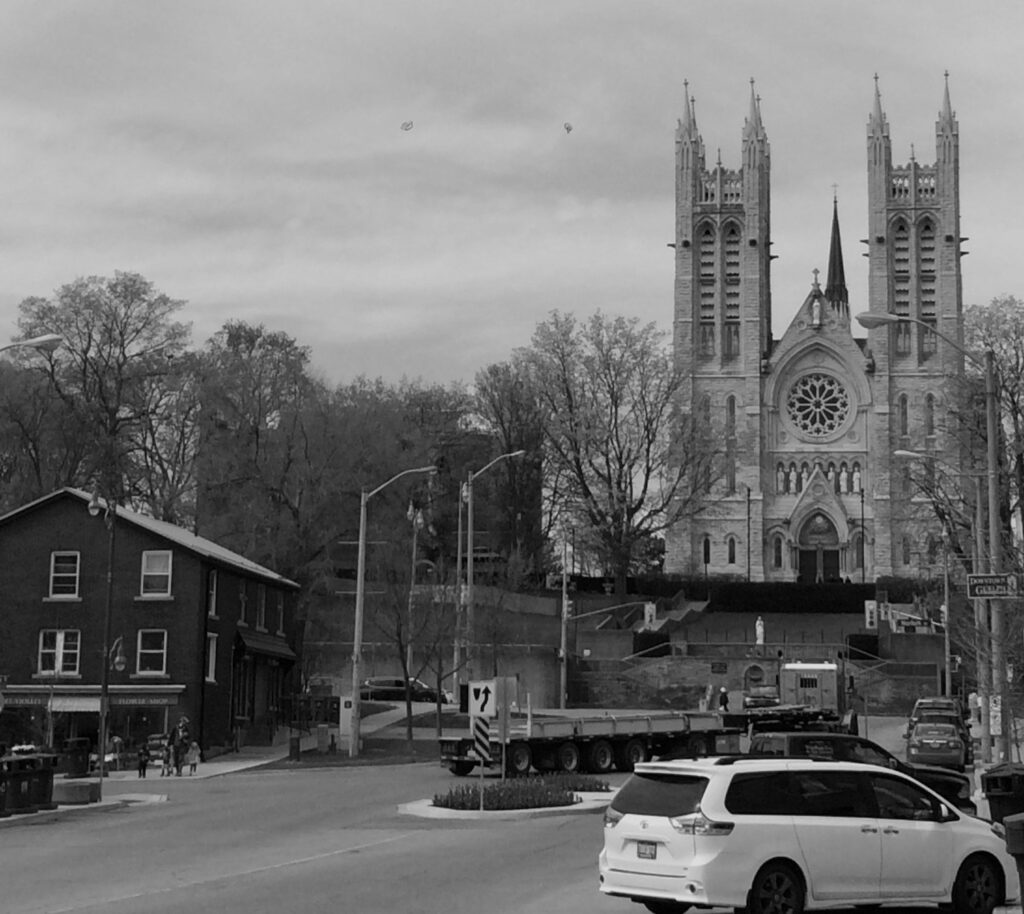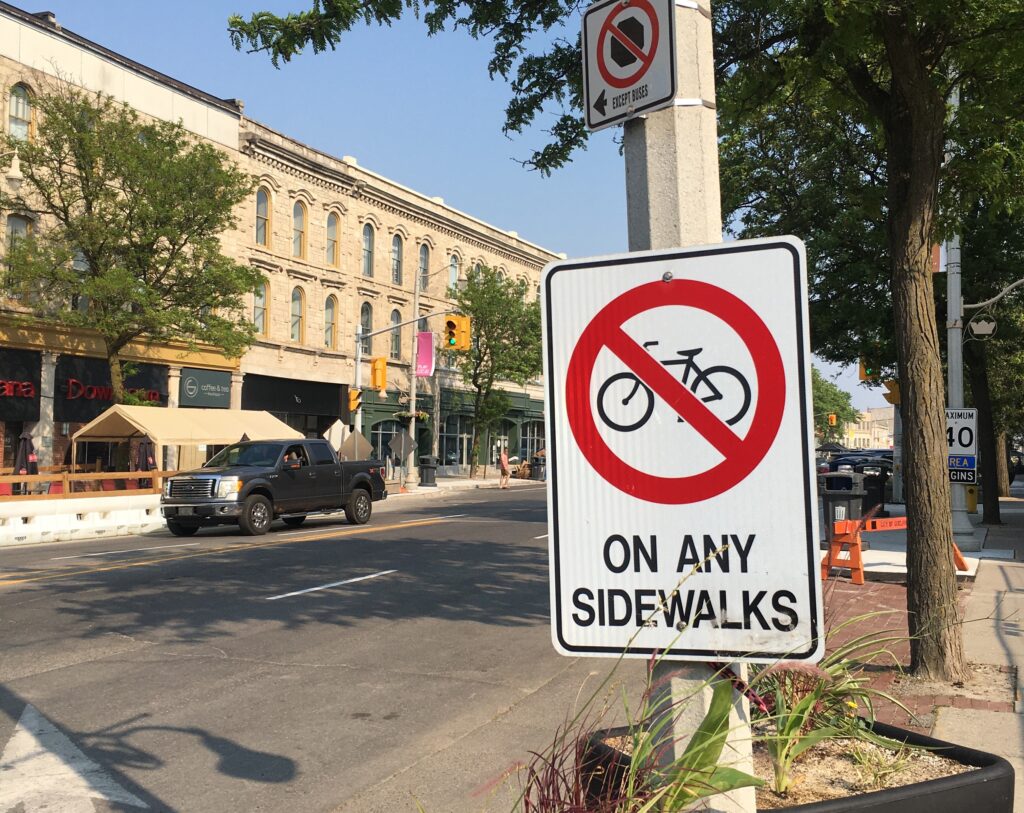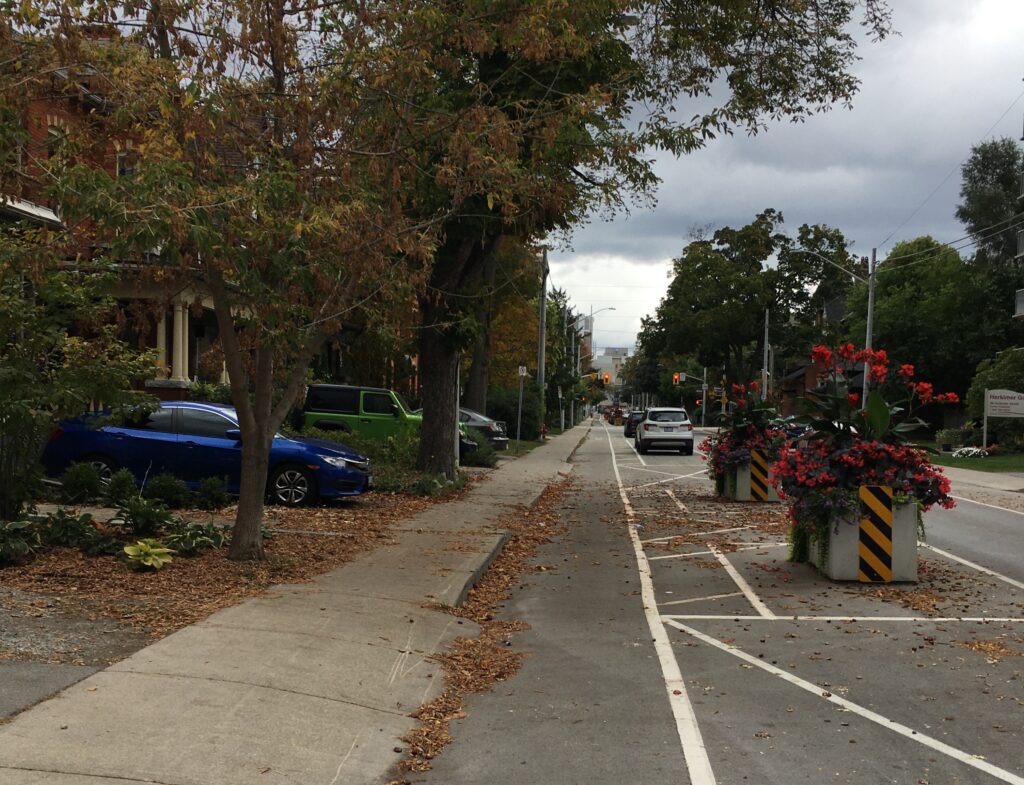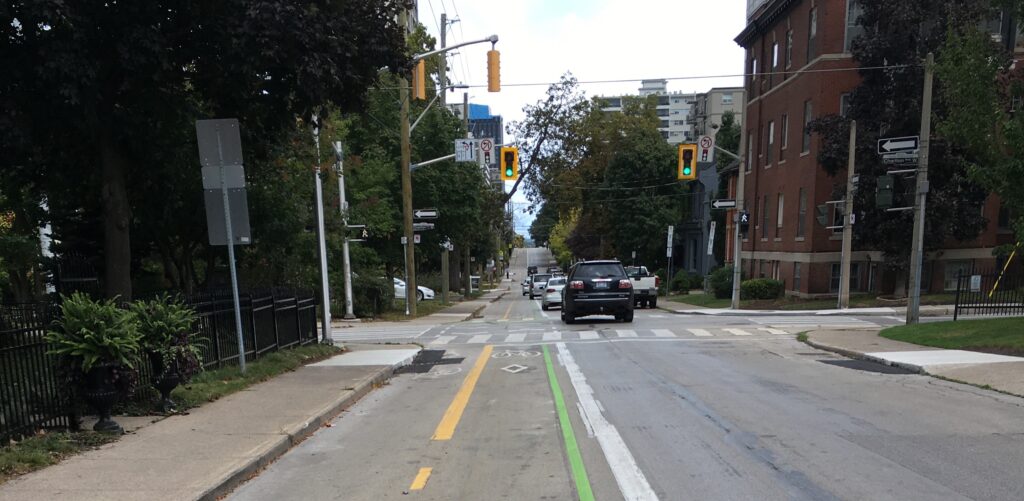
Moving Towards a Car-Free Downtown Guelph
In 2020, Guelph mayor Cam Guthrie indicated 1 that part of his vision for the long-term future of downtown Guelph includes a car-free zone. Car-free urban cores are the logical next-step for North American cities to take in terms of the future of urban development, but progress has been slow. Major changes, such as a ban on cars in the downtown core, are regularly contested by the “defenders of the status quo”, who in this case, seem to be comprised of a few members of Guelph’s Downtown Business Association.
After a successful pilot of the car-free pedestrian zone in 2020, the city voted against making this change to the downtown core permanently (the car-free zone was only a small area downtown around Wyndham and Macdonnell)—likely due to opposition from the previously mentioned opposing businesses. In a private survey presented in 2021 2 to Guelph city council, the majority of respondent businesses indicated that they thought the car-free zone did not hinder their business. Only a small number of businesses surveyed were opposed to the return of the car-free zone, and of those few, some stated because it was implemented “unfairly”—some businesses were excluded from the car-free zone which saw less foot traffic. This is a reason in-itself to make the downtown in its entirety car-free.
The content written in this post is not intended to convince the reader that a car-free downtown is better or worse than our current situation of a downtown filled with on-street parking and traffic—a car-free downtown is better for the majority of people 3, and there is plenty of additional academic research to support this conclusion. The following post outlines small, progressive steps the city can take towards moving in the right direction, and ultimately realizing the mayor’s goal of a car-free downtown.
1. Introduction of Traffic-Calming Measures
Wealthy residential neighbourhoods with the resources and time to advocate for their immediate communities contain traffic-calming measures such as speed bumps on their roads. Avoiding a detailed discussion of the systemic inequality that exists between these neighbourhoods and comparatively poorer areas, few would debate the benefits of applying traffic-calming measures more universally across the city. Downtown is no exception, but speeds bumps and protected bike lanes are notably absent from most major downtown Guelph streets.

Traffic-calming infrastructure not only makes roads safer—it also provides many psychological benefits, such as those that accompany reductions in urban noise.
In addition to creating one-way streets, and increasing bike lanes, which will be discussed in more detail later, there are three primary mechanisms that are suitable for implementation on the roads of downtown Guelph:
- Speed Bumps
- Ideally of the same style as those constructed on Downey Road, which really forces cars to slow down significantly when implemented across the full width of a lane.
- Lane Narrowing
- Smaller road lanes forces car drivers to reduce their speed, reduces traffic volume, and allows for re-purposing of the the additional land that has been freed.
- Curb Separators and Islands
- Physical barriers like curbs, raised walkways, or planters prevent dangerous passing attempts by vehicles and force traffic into more predictable flows.
2. Conversion of On-Street Parking to Protected Bike Lanes
The legacy on-street parking in downtown Guelph is poorly implemented, and particularly absurd now that there is a huge, mostly unused parking garage directly beside city hall; a short walk from the majority of the downtown core. By removing all on-street parking on the major downtown roads like Wyndham, Macdonnell, Carden, Quebec Street, and other roads, the already paved on-street parking spaces would become immediately available and easily convertible to high-quality, protected bike lanes. If built in combination with traffic-calming in mind, this simple change would achieve all of the following:
- Increase the total kilometres of bike lanes downtown
- Allows sustainable travel methods to move through the downtown more safely and efficiently.
- Narrows existing road lanes
- Forces cars to reduce speed, and introduces the other benefits previously mentioned.
- Increased revenues for the city of Guelph
- Resulting from more drivers parking in the new parkade beside city hall.

3. Conversion to One-Way Streets
Many other major Canadian cities have large networks of one-way streets. Hamilton, Ontario has implemented the use of one-ways particularly well. In Guelph, a one-way loop from Gordon & Wellington Street East, around to the intersection of Woolwich and Norfolk streets, then back down Norfolk to Wellington, would be a good first step for the downtown core. There are a number of additional streets that run through Guelph’s core that would be well-suited to conversions to one-way streets:
- Wyndham Street
- From Wellington to Woolwich—traveling in a south-to-north direction
- Quebec Street
- From Norfolk to Wyndham—traveling in a west-to-east direction
- Carden Street
- From Wyndham to Wilson—traveling in an east-to-west direction
- Macdonell Street
- From Wellington to Norfolk—traveling in an east-to-west direction
- Cork Street
- From Wyndham to Norfolk—traveling in a west-to-east direction

4. Eventual Restriction of Road Access to Commercial, Emergency Vehicles
Once some of the traffic-calming measures, protected bike lanes, narrowed lanes, and one-way streets are in place, there will already be reduced traffic volumes downtown. At this point, the city can begin to restrict access to major one-way roads to commercial and emergency vehicles only (with residential exceptions via permits for those with addresses within the one-way loop described above). To enforce such a change, new bylaws would be required to allow new ticketing policies for unauthorized vehicles who drive on the restricted-access roads illegally (ideally with a high penalty cost to act as a real deterrent).
Much of the influence for these ideas comes from having lived in the Plateau Mont Royal neighbourhood of Montréal and parts of Montréal’s downtown core, where they have already implemented most of these ideas in a far busier area than downtown Guelph, with success 4.
Avoiding Urban Planning Mistakes Like South Guelph
South Guelph, by most accounts, is an example of a wasted opportunity for progressive urban development. Why? It was developed completely for the car. South Guelph was mostly farm land until recently—one would think a post-2000s urban neighbourhood would have been designed in a more progressive way.
South Guelph is a hostile area for walking or cycling. This is largely to huge amounts of land used solely for parking lots and four-lane roads, and very little attention paid to walkability. South Guelph’s urban development outcome—like many of Ontario’s poorly planned young neighbourhoods that are blandly constructed around cheaply-built subdivisions and low-quality parking lot franchises—arguably contributes to many psychological issues associated with isolation; it has fallen victim to the car-centric individualism that plagues so much of urban Ontario and hinders the progressive development of its cities. South Guelph’s style of development encourages residents to stay home, or to ride in their cars, and little else.
Concluding Summary
There was a time when Guelph was one of the most progressive cities in Southern Ontario. While this status has been eroded over time by poor urban planning decisions, refactoring the structure of the downtown core for livability instead of drivability could help correct the city’s path back towards being a progressive small city once again.
The road changes proposed in this article are cheap, relatively easy to implement, and can be built progressively, one step at a time.
References
- Wong, Carmen. (2020, February 9). Guelph mayor envisions car-free downtown, free transit for youth. CTV Kitchener. https://kitchener.ctvnews.ca/guelph-mayor-envisions-car-free-downtown-free-transit-for-youth-1.4804053
- McKillop, Cara. (2021, March 26). Car-Free Pedestrian Zone Pilot Project – 2021 Proposal. City of Guelph. https://pub-guelph.escribemeetings.com/filestream.ashx?DocumentId=14047
- Nieuwenhuijsen, M., Khreis, H. (2016, March 1). Car free cities: Pathway to healthy urban living. Environment International. https://sci-hub.st/https://doi.org/10.1016/j.envint.2016.05.032
- Andrew-Gee, Eric. (2023, July 4). Montreal avenue’s car-free transformation proves a hit with residents, business owners. The Globe and Mail. https://www.theglobeandmail.com/canada/article-montreal-avenues-car-free-transformation-proves-a-hit-with-residents/